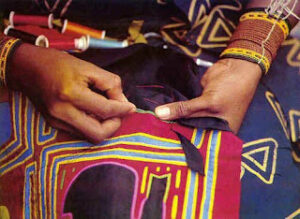History


SeViewal studies of this culture maintain that the molas arose when the Kunas migrated from the mainland to the islands, in the mid XIX century; that is, when they came into contact with other peoples. According to the elders, Kunas, the molas originated when on the banks of the Disuknu RiView, there lived an ancient town with a tribal organization and the divine province sent Ibeorgun, accompanied by her sister Olokikadiryai, to give instructions on the design and making of molas to the towns of the Yco riView.
With this story,The Kuna affirm that the molasthey are an integral part of their cultural contribution. But they are also convinced that the molas did not arise by chance, but were imitation of the geometric body painting of their ancestors. son parte integrante de su aporte cultural. Pero tamThey are also convinced that the molas did not arise by chance, but that they were an imitation of the geometric body painting of their ancestors.
Confection


The molas are made with fabrics and threads of different colors. The elaboration of the molas is an exclusive occupation of women, who exercise them since childhood and, when adults, become Viewy skilled in this work. Although they are all great seamstresses, not all of them achieve the skill necessary to design molas. In other words, there are Viewy small groups of women who dedicate themselves to designing and instructing their peers while the majority take care of sewing them. The figures of the molas are usually anthropomorphic, zoomorphic or also inspired by recently incorporated foreign elements, such as airplanes, flags, etc. The variety is as infinite as the perception of indigenous women.
Molas prices vary according to artistic quality, size and density.
There is no formalized institution for teaching this activity. Each household follows her in its own way. the instructors are the grandmothers, mothers, aunts or some neighbor. The elaboration of the molas can last between ten days to six months, depending on the dedication or the time required for the complex geometric sketch.
The women usually make the Molas during their leisure time, in various places: in the house of the Local Congress, where they meet with the Sáhilas; on the beach, where they wait for the thick people who come from the countryside: when they make a long trip in a canoe; at the airport, where they await the arrival of relatives from the capital.
